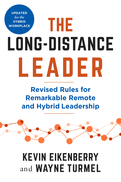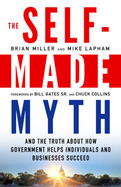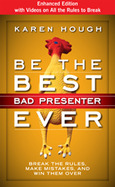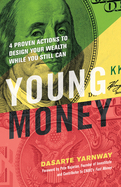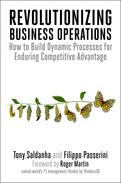When The Long-Distance Leader was first published, it was pre-pandemic and remote work was in its infancy with 30% of managers leading at a distance—now that number is well over 50%.
As more organizations adopt a remote workforce, the challenges of leading at a distance become more urgent than ever. The cofounders of the Remote Leadership Institute, Kevin Eikenberry and Wayne Turmel, show leaders how to guide their teams by recalling the foundational principles of leadership whether their teams are remote, hybrid, co-working, or something entirely new!
The authors' "Three-O" Model refocuses leaders to think about outcomes, others, and ourselves—elements of leadership that remain unchanged, whether employees are down the hall or halfway around the world. By pairing it with the Remote Leadership Model, which emphasizes using technology as a tool and not a distraction, leaders can navigate the terrain of managing teams wherever they are.
This second edition features updated exercises that ensure projects stay on track, keep productivity and morale high, and build lasting relationships, along with a new chapter on hybrid workplaces.
2013
We still face the challenge of fostering ownership and accountability throughout our organizations. Despite all the evidence calling for profound change, most organizations still rely on patriarchy and control as their core form of governance. The result is that they stifle initiative and spirit and alienate people from the work they do. This in the face of an increasing need to find ways to be responsive to customers and the wider community.
Peter Block insists that what is required is a dramatic shift in how we distribute power, privilege, and the control of money. “Stewardship,” he writes, “means giving people at the bottom and the boundaries of the organization choice over how to serve a customer, a citizen, a community. It is the willingness to be accountable for the well-being of the larger organization by operating in service, rather than in control, of those around us.”
Block has revised and updated the book throughout, including a new introduction addressing what has changed—and what hasn't—in the twenty years since the book was published and a new chapter on applying stewardship to the common good of the wider community. He covers both the theory of stewardship (in particular how it ameliorates the shortcomings of traditional leadership) and the practice (how it transforms every function and department for the better). And he offers tactical advice as well on gearing up to implement these reforms.
2012
Exposes the damage caused by the myth of the "self-made man" and reveals how wealth is actually created.
The Self-Made Myth exposes the false claim that business success is the result of heroic individual effort with little or no outside help. Brian Miller and Mike Lapham bust the myth and present profiles of business leaders who recognize the public investments and supports that made their success possible—including Warren Buffett, Ben Cohen of Ben and Jerry’s, New Belgium Brewing CEO Kim Jordan, and others. The book also thoroughly demolishes the claims of supposedly self-made individuals such as Donald Trump and Ross Perot. How we view the creation of wealth and individual success is critical because it shapes our choices on taxes, regulation, public investments in schools and infrastructure, CEO pay, and more. It takes a village to raise a business—it’s time to recognize that fact.
This enhanced edition of Be the Best Bad Presenter Ever includes 13 exclusive videos that show you how to be a memorable, effective presenter by breaking all the rules. These videos offer a unique learning experience as author Karen Hough walks you through the good, the bad, and the ugly in the world of presentations. Watch as she and her colleagues model how to communicate ideas with care and authenticity, while poking fun at the ridiculous habits that are considered the norm in giving presentations.
* Shows how ripping up the traditional presentation dos and don'ts will make you a better, more relaxed, and more effective presenter
* Takes on over a dozen pieces of "good" presentation advice and reveals why they actually make you worse
* Features stories of people who not only were able to become great presenters by being "bad" but actually came to enjoy it
Gold Honoree, Benjamin Franklin Digital Book Awards
Most of us have received unhelpful advice like this before: cling to the podium, when in doubt use bullet-points, and suppress your nerves before they suppress you. Thankfully, Karen Hough debunks these myths and shows you how to be a presenter who makes a genuine connection with the audience--the type of connection that inspires people to take actionWith 25 minutes of lively and engaging video, this enhanced edition copy will change everything you thought you knew about presentations. Join Karen Hough as she teaches you how to be the best bad presenter you can be, so that what you say will actually make a difference.
With 25 minutes of lively and engaging video, this enhanced edition copy will change everything you thought you knew about presentations. Join Karen Hough as she teaches you how to be the best bad presenter you can be, so that what you say will actually make a difference.
If you're like most people, the phrase "You'll be giving a presentation" is on a par with "It looks like that molar will have to come out." Well, let's be honest: you'd prefer the surgery, wouldn't you?
One reason most people regard public speaking as a nightmare is that they have to be "perfect." They drive themselves crazy trying to conform to all sorts of handed-down rules that tie them up in knots and put their audiences to sleep. But Karen Hough knows that by throwing out those rules, relaxing, being yourself, and even making "mistakes," you'll connect with your audience much more effectively than the guy with the impeccable PowerPoint presentation.
Hough has used her unique approach to take the anxiety out of one of the greatest fears in business. It's authenticity and passion that win people over, she says, not polish. It's why people trust vlogs more than commercials and user reviews more than ads. But you can't be authentic if you're following constraining rules that drain the life and personality out of your presentation.
Hough debunks over a dozen myths about presenting to make it more fun and natural for everybody. She explains why mirrors are evil, why you should never end with questions, what the real purpose of any presentation should be, and much more. You'll discover how to embrace and develop your own style and communicate your message in a way that's all "wrong" according to the experts and that your audiences will find compellingly right.
If presentations really didn't matter, we'd all just send memos. There are a million ways to share information out there, but the more we digitize, the more we long for human connection. By following Karen Hough's wise and witty advice, you'll avoid being forced to become one more robot behind a podium and be freed to be a living, breathing, occasionally clumsy real person whose passion is powerful and infectious.
2018
If you're under 40, you may not have a lot of money, but you're loaded with a valuable resource: time. It probably doesn't seem like it when you're looking at your student loan debt or scraping up rent money each month, but being young is the ultimate advantage when it comes to building wealth. Starting now means you can experiment, learn from mistakes, bounce back from setbacks, and steadily build your legacy.
Rising-star financial advisor Dasarte Yarnway offers a simple 4-step process you can use to become a Master Wealth Builder. It begins with having the right mindset—wealth begins in your mind and then is built every day through intentional actions. Yarnway examines:
• The 4 most common financial pitfalls and how to avoid them
• The 5 habits all Master Wealth Builders engage in
• The 3 best ways to master your income
• 7 simple practices for controlling costs
A worksheet helps you assess exactly where you are financially, where you want to go, and how you're going to get there. So start now! As Warren Buffett said, “Someone is sitting in the shade today because someone planted a tree long ago.” The sooner you plant, the more shade you'll have.
If you have a great product, but don't have the operations in place to efficiently and effectively support it-production, manufacturing, sales, finance, human resources, etc.-you won't succeed. Product innovation is seen as flashier and so gets far more attention, but you can create an enduring competitive advantage by revolutionizing business operations.
The problem is most attempts to improve business operations are reactive, sporadic, and siloed. Tony Saldanha and Filippo Passerini's Dynamic Process Transformation model provides a living model for constant, ongoing process evolution and optimization.
The authors focus on maximizing three drivers of change. First, open market rules-each business process must be run as a separate business, instead of via monolithic mandates coming down from on high. Second, there must be unified accountability- outcomes must be clear and consistent across the company, instead of being siloed within departments. And third, there needs to be a dynamic operating engine, a methodology to convert the constantly changing business process goals into tactical day-to-day employee actions.
With numerous examples from leading companies, this book shows how to proactively keep business processes across the company from becoming obsolete and take advantage of a neglected key to success.


